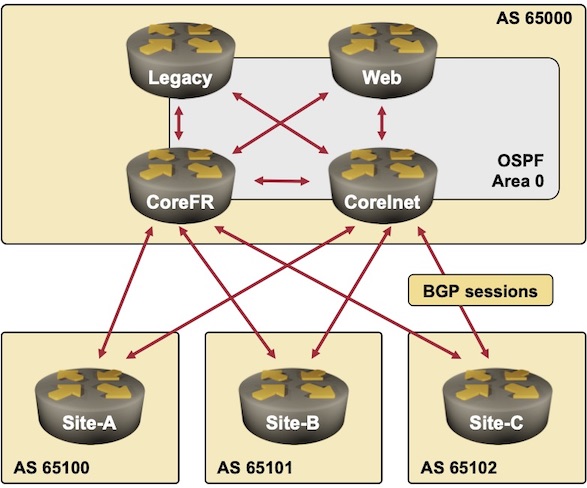Basic Routing Design
Articles » Scalable Policy Routing » Basic Routing Design
The whole network uses BGP as its core routing protocol, giving us a highly-scalable solution with the inherent capability to implement policy-based routing (most of the BGP’s complexity is a direct result of its abilities to perform policy-based routing decisions). Each site is a separate autonomous system (AS); remote sites have one or two routers in their AS and the central site can have as many routers as needed, using the two core routers as BGP route reflectors. OSPF is also deployed in the core site to ensure fast convergence and solve the BGP next-hop problems. The overall routing design is displayed in the next diagram:

Basic Routing Design
You could decide to simplify the router configuration by redistributing directly connected routes into the BGP on each router, but this would just pollute the BGP tables with the point-to-point WAN subnets that are usually not needed for proper network operation. It’s thus better to manually list the networks you want to announce in the BGP routing process. The sample configuration from one of the remote sites is included in the next listing:
router bgp 65100
network 10.0.1.1 mask 255.255.255.255
network 192.168.1.0
To make the core router configurations as scalable as possible, we’re using BGP peer policy and peer session templates. These template mechanisms might look verbose if you have only a few neighbors, but the ease-of-management they give you quickly pays off – if you have to make a change in your BGP configuration, you change the settings in one place and they get propagated to all BGP neighbors automatically. For example, the core BGP routers use several templates:
- The LocalAS session template is used to create all peers in the same AS;
- The Global policy template defines rules that apply to all neighbors (community propagation is configured in this template);
- The RRClient template covers all the other routers in the central site;
- The RemoteSite template specifies parameters for the BGP neighbors on remote sites.
Here are the BGP templates used on the CoreInet router:
router bgp 65000
template peer-policy Global
send-community both
!
template peer-policy LocalAS
inherit peer-policy Global 1
!
template peer-policy RRClient
route-reflector-client
inherit peer-policy Global 1
!
template peer-policy RemoteSite
inherit peer-policy Global 1
!
template peer-session LocalAS
remote-as 65000
update-source Loopback0
And this is how those templates are used to configure BGP neighbors:
router bgp 65000
neighbor 10.0.1.3 description CoreFR
neighbor 10.0.1.3 inherit peer-session LocalAS
neighbor 10.0.1.3 inherit peer-policy LocalAS
!
neighbor 10.0.1.4 description Legacy
neighbor 10.0.1.4 inherit peer-session LocalAS
neighbor 10.0.1.4 inherit peer-policy RRClient
!
neighbor 10.0.1.20 description Web
neighbor 10.0.1.20 inherit peer-session LocalAS
neighbor 10.0.1.20 inherit peer-policy RRClient
!
neighbor 10.0.11.2 description Site-A
neighbor 10.0.11.2 remote-as 65100
neighbor 10.0.11.2 inherit peer-policy RemoteSite
!
neighbor 10.0.11.6 description Site-B
neighbor 10.0.11.6 remote-as 65101
neighbor 10.0.11.6 inherit peer-policy RemoteSite
!
neighbor 10.0.11.10 description Site-C
neighbor 10.0.11.10 remote-as 65102
neighbor 10.0.11.10 inherit peer-policy RemoteSite
On the other hand, the routers on the remote sites have just two BGP neighbors. Implementing peer templates is thus overkill, the traditional BGP configuration is used on remote sites:
router bgp 65100
neighbor 10.0.8.1 remote-as 65000
neighbor 10.0.8.1 description CoreInet
!
neighbor 10.0.11.1 description CoreFR
neighbor 10.0.11.1 remote-as 65000
